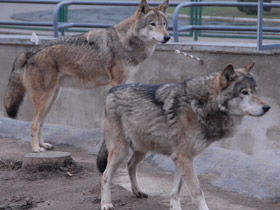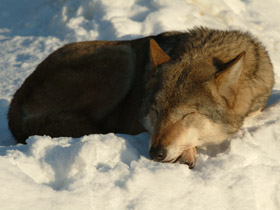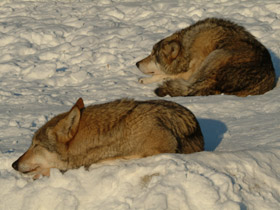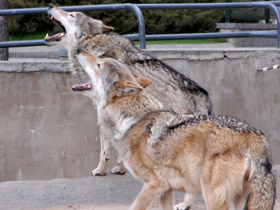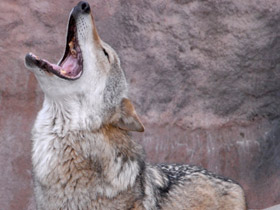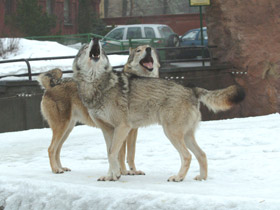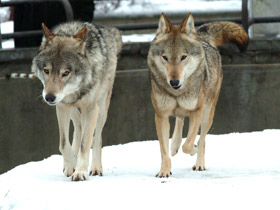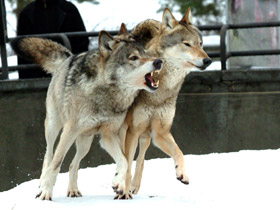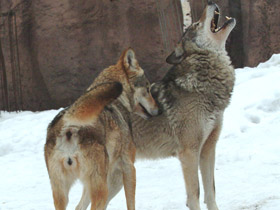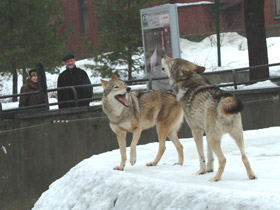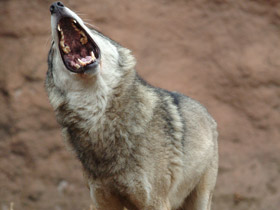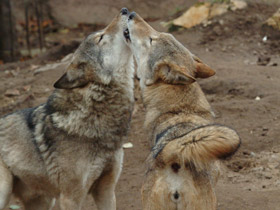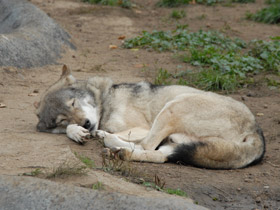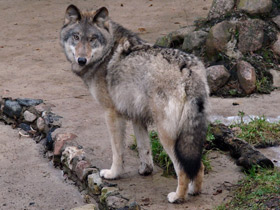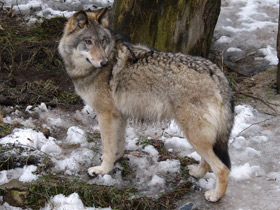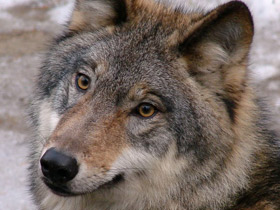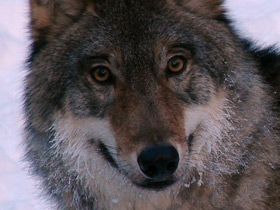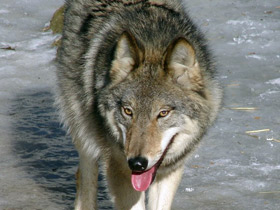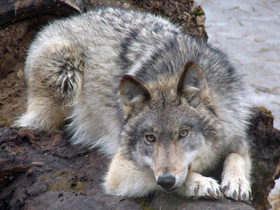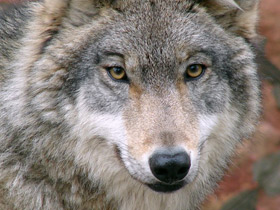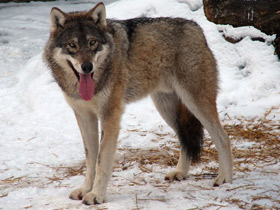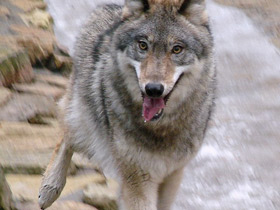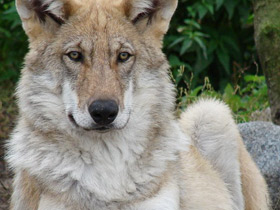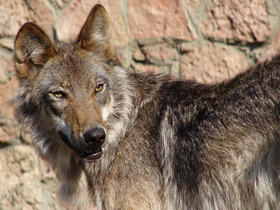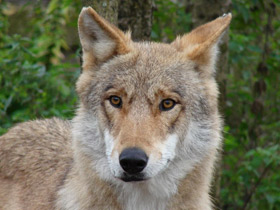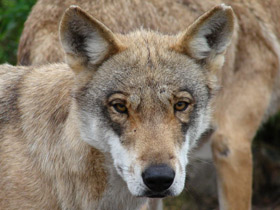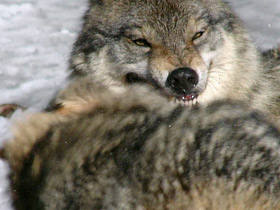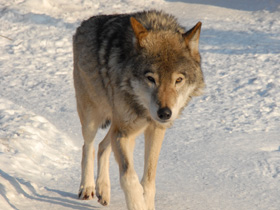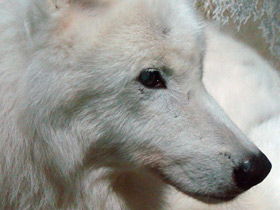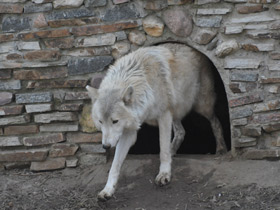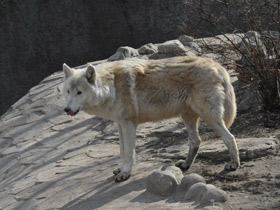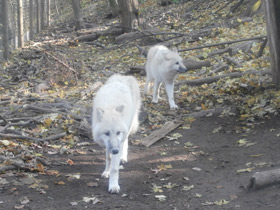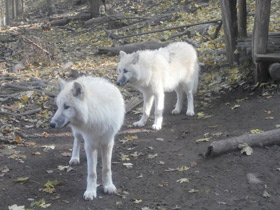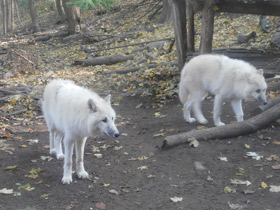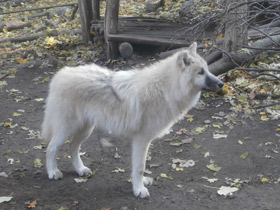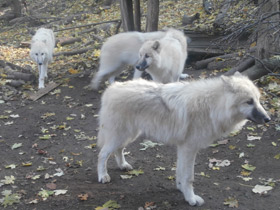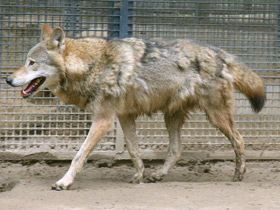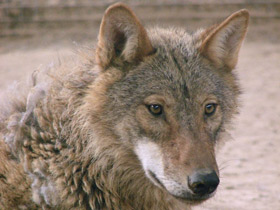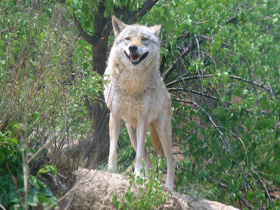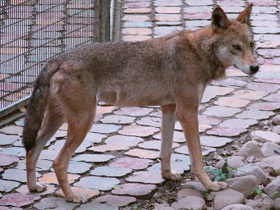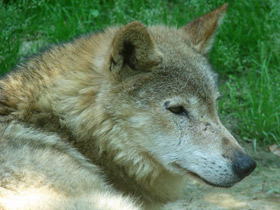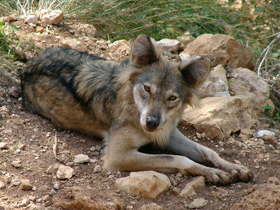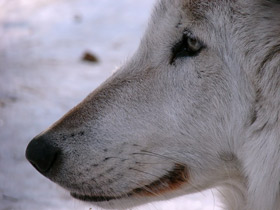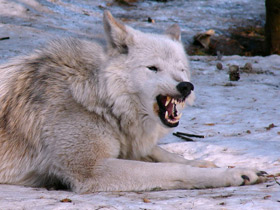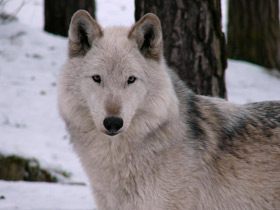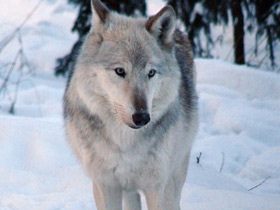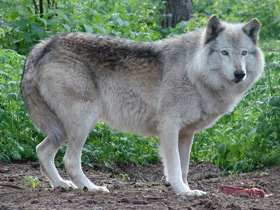The wolf, the gray wolf or grey wolf (Canis lupus)
The wolf (Canis lupus; pl.: wolves), also known as the gray wolf or grey wolf, is a large canine native to Eurasia and North America. More than thirty subspecies of Canis lupus have been recognized, including the dog and dingo, though gray wolves, as popularly understood, only comprise naturally-occurring wild subspecies. The wolf is the largest extant member of the family Canidae, and is further distinguished from other Canis species by its less pointed ears and muzzle, as well as a shorter torso and a longer tail. The wolf is nonetheless related closely enough to smaller Canis species, such as the coyote and the golden jackal, to produce fertile hybrids with them. The wolf's fur is usually mottled white, brown, gray, and black, although subspecies in the arctic region may be nearly all white.
Canis lupus is a species of placental mammal of the carnivore order. It is difficult to find a more charismatic animal than the wolf, which is so closely associated with man. In ancient times, humans worshipped the wolf and considered it their ancestor. They followed packs of agile and skilful hunters and did not disdain to gorge themselves on their prey. The constant proximity and cunning of this beast undoubtedly served to domesticate it.
The domestic dog (Canis familiaris) was considered to be a member of the same species according to various indications, DNA sequencing and other genetic studies. However, it was not until 1758 that it was considered a distinct species by biologists.
Nevertheless, man and wolf have always been rivals, and the history of their relationship is full of drama. There was a time when the wolf was considered the number one enemy, and there was a significant reward for killing it. This has resulted in the wolf disappearing completely in most European countries and being on the verge of extinction in many parts of the world.
Attitudes towards the wolf began to change radically in the middle of the last century in connection with the modern understanding of the principles of natural community organisation. The wolf was recognised as an important regulator of wild ungulate numbers, and was referred to as the "forest sanitary". Some countries even began to consider the possibility of reintroducing this species into their territories.
Appearance
Canis lupus is the largest of the canine family. It is a splendid, well-proportioned animal with slender, strong legs, a powerful head and neck, and an elongated snout with "sideburns". Males are slightly larger than females and differ from them in having a more closely set head (photo 1). The teeth and jaws of these predators are so strong that they can crush very large bones (e.g. the femur of a moose) (photo 11). The coat of Canis lupus is thick, fairly long and consists of two layers. The first layer consists of stiff hairs that repel water and dirt, while the second layer, a downy undercoat, has excellent insulating properties. Thanks to this coat, the Canis lupus hardly freezes or gets wet; for example, it can sleep safely on snow in winter (photo 2, 3).
Social behaviour and peculiarities
Canis lupus live in packs of 2 to 20 animals. The pack is usually a large family consisting of parents and offspring of several generations, but sometimes unrelated animals join the pack. They remain as "uncles" and help raise young, hunt and guard the area.
The basis of a family is a breeding pair, which usually lasts a lifetime unless one member of the pair dies (photo 7, 12).
Each family reserves and guards a specific feeding area, where "outsiders" are not allowed. Canis lupus mark the boundaries of their territory with scent markers - they spray urine on stumps and large stones - and inform their neighbours of their rights by howling.
The wolf's howl is a truly magnificent means of communication. A human can hear it 3-4 km away, wolves can hear it up to 10 km away. Thanks to howling, the members of the pack always know where each other is, what each other is doing and where their neighbours are hunting. Their parents howl to inform their cubs that they are approaching their prey, and the cubs tell them where they are. Animals can use their voices to communicate more complex messages, such as the location of potential prey or the arrival of humans. Most importantly, wolf howls create a harmonious atmosphere in the pack and promote unity (photo 4, 5, 6).
We can tell the wolf's behaviour in the pack by its mimicry, posture and movements, as well as by the position of its ears, head, tail, lips and coat. A confident wolf shows with his whole appearance how big, strong and powerful he is: that is why he walks with his back straight and his head high, and his tail is tucked or stretched horizontally, and his ears are pointed. When he threatens mischief-makers, he shows his fangs and raises but does not stretch his lips. But these extreme measures are quite rare in a friendly pack. Often, a simple glance is enough to put a subordinate in his place.
Canis lupus often show friendly feelings towards their mates, which is very important for pack cohesion. The easiest way to relieve tension and spread good humour is to play, and wolves love to play (photo 8, 9, 10). They have a form of collective mutual greeting: whinnying, the wolves rub each other enthusiastically, nudge each other, lick each other's muzzles (photo 12). This ceremony, as well as the howling of the group, raises the general mood.
Canis lupus are skilful and resourceful hunters, they are highly intelligent and their behaviour is very complex and coordinated. In a herd chasing an elk or a deer, some predators will run after their prey, others will cut them off, while others will lie in ambush to make a decisive move at the right moment.
Arctic wolf (Canis lupus arctos)
Grey wolf видео
The Arctic wolf (Canis lupus arctos), also known as the white wolf, polar wolf, and the Arctic grey wolf, is a subspecies of grey wolf native to the High Arctic tundra of Canada's Queen Elizabeth Islands, from Melville Island to Ellesmere Island. Unlike some populations that move between tundra and forest regions, Arctic wolves spend their entire lives north of the northern treeline. Their distribution to south is limited to the northern fringes of the Middle Arctic tundra on the southern half of Prince of Wales and Somerset Islands. It is a medium-sized subspecies, distinguished from the northwestern wolf by its smaller size, its whiter colouration, its narrower braincase, and larger carnassials. Since 1930, there has been a progressive reduction in size in Arctic wolf skulls, which is likely the result of wolf-dog hybridization.
Description and habitat
Canis lupus arctos is a mammal of the family Canidae, subspecies of the wolf.
Canis lupus arctos is found in most of the Arctic, except where there is a lot of ice. It is about 60-80 cm long and weighs up to 80 kg, females may weigh less. They live in flocks of up to 10 individuals, feeding on hares, reindeer and other animals. Pup size ranges from 4 to 5 pups (in some related species of this wolf, 2 to 3 pups are more common). However, Canis lupus arctos is the best adapted to life: it can go for weeks without food and live in sub-zero temperatures. Temperatures in the Arctic winter exceed 50 degrees Celsius.
Canis lupus arctos has everything it needs to survive in the Arctic: a warm, wind-resistant coat, keen eyesight, hunting skills and an excellent sense of smell.
Hunting and nutrition
Canis lupus arctos usually always hunt in a herd, the only way they can catch large ungulates: musk oxen, reindeer and sometimes elk, when they have fallen into deep snow and cannot offer resistance to the herd. However, Canis lupus arctos never ambushes. If the musk oxen have already managed to defend themselves in a circle (which is most often the case), Canis lupus arctos will run around them until the musk oxen can stand it and scatter in different directions. However, even then, their hunt is not always successful.
Canis lupus arctos can live without food for weeks, but can eat about 10 kilos of meat at a time. As a single wolf cannot kill a large animal, it will hunt hares, lemmings, birds and other small animals. Lone wolves are usually young animals that have left the pack and gone in search of separate areas.
Reproduction and lifestyle
Canis lupus arctos are monogamous. In March, the female finds shelter or digs a den herself. In May-June, after two months of pregnancy, a she-wolf gives birth to deaf, blind and totally defenceless cubs. They stay with the female in her den for three weeks and only then begin to explore the outside world.
At three months of age, they begin to accompany their mother when hunting with the pack.
The Canis lupus arctos herd usually leads a nomadic lifestyle. Due to the lack of pasture, the reindeer have to roam over a vast area, covering about 2,600 km². Canis lupus arctos often follow them, travelling long distances.
The Himalayan wolf (Canis lupus chanco)
The Himalayan wolf (Canis lupus chanco) is a canine of debated taxonomy. It is distinguished by its genetic markers, with mitochondrial DNA indicating that it is genetically basal to the Holarctic grey wolf, genetically the same wolf as the Tibetan and Mongolian wolf, and has an association with the African wolf (Canis lupaster). No striking morphological differences are seen between the wolves from the Himalayas and those from Tibet. The Himalayan wolf lineage can be found living in Ladakh in the Himalayas, the Tibetan Plateau, and the mountains of Central Asia predominantly above 4,000 m (13,000 ft) in elevation because it has adapted to a low-oxygen environment, compared with other wolves that are found only at lower elevations.
Some authors have proposed the reclassification of this lineage as a separate species. In 2019, a workshop hosted by the IUCN/SSC Canid Specialist Group noted that the Himalayan wolf's distribution included the Himalayan range and the Tibetan Plateau. The group recommends that this wolf lineage be known as the "Himalayan wolf" and be classified as Canis lupus chanco until a genetic analysis of the holotypes is available. The Himalayan wolf lacks a proper morphological analysis. The wolves in India and Nepal are listed on CITES Appendix I as endangered due to international trade.
Taxonomy
Canis chanco was the scientific name proposed by John Edward Gray in 1863, who described a skin of a wolf that was shot in Chinese Tartary. This specimen was classified as a wolf subspecies Canis lupus chanco by St. George Jackson Mivart in 1880. In the 19th and 20th centuries, several zoological specimens were described:
- Canis niger by Philip Sclater in 1874 was a wolf specimen collected near Hanle in Kashmir.
- Lupus filchneri by Paul Matschie in 1907 was a wolf skin from Xining in China's Qinghai province. It had been collected by Wilhelm Filchner during an expedition to China and Tibet in 1903–1905.
- Lupus karanorensis by Matschie in 1907 was a skin and a skull of a wolf that was shot in an oasis near Dunhuang in China in 1894.
- Lupus tschiliensis by Matschie in 1907 was a skull of a wolf specimen that was shot in the coastal region of China's Zhili province.
- Canis lupus coreanus by Yoshio Abe in 1923 was a wolf specimen from the vicinity of Seoul in the Korean Peninsula.
In 1938, Glover Morrill Allen classified these specimens as synonyms for C. l. chanco. In 1941, Reginald Pocock corroborated this assessment after reviewing wolf skins and skulls in the collection of the Natural History Museum, London. In 2005, W. Christopher Wozencraft also listed Canis lupus niger, Canis lupus filchneri, Canis lupus karanorensis, and Canis lupus tschiliensis as synonyms for Canis lupus chanco.
Description and habitat
Canis lupus chanco is a subspecies of wolf that is quite light in colour, almost white underneath.
Canis lupus chanco was identified as a subspecies of the grey wolf as early as 1863 by the British zoologist John Edward Gray. It is common in China, Manchuria and Mongolia, and can be found in Tibet, the Himalayas and southwestern Russia. Compared to the grey wolf, the Tibetan wolf is slightly larger but has a shorter nose.
Some scientists consider it to be the most likely ancestor of the domestic dog, as it bears some morphological similarities to the dog, unlike other subspecies of the grey wolf.
Hunting and nutrition
Canis lupus chanco is an excellent hunter and can hunt alone or in packs at any time of the day. It can feed on deer, blue sheep and other large mammals, as well as marmots, hares, ground squirrels and mice.
Reproduction
Canis lupus chanco breeds in spring, with only the dominant pair having cubs in the herd. After a two-month pregnancy, the she-wolf gives birth to 4-6 pups. They start to come out of the den at 3-4 weeks of age. The mother feeds her cubs with milk for 2-3 months and later they accompany their parents when hunting. Young Canis lupus chanco reach sexual maturity in the second year of life, and Canis lupus chanco can live 6-10 years in the wild; in captivity, they can live up to 20 years.
The Arabian wolf (Canis lupus arabs)
The Arabian wolf (Canis lupus arabs) is a subspecies of grey wolf native to the Arabian Peninsula, western Bahrain, as well as Oman, southern Saudi Arabia and Yemen. They are also found in the Negev and Arava deserts of Israel, Jordan, Palestine and Egypt's Sinai Peninsula. It is the smallest subspecies of grey wolf and a specialised xeroculture animal (adapted to arid areas) that normally lives in smaller family packs. Arabian wolves are omnivores and opportunistic feeders, consuming small to medium-sized prey ranging from insects, reptiles and birds to rodents and small ungulates, such as baby Nubian ibex and several species of gazelle (Arabian, boba, Dorcas and mountain gazelle).
Taxonomy
The British zoologist Reginald Innes Pocock designated the Arabian wolf in 1934 as Canis lupus arabs, although it was previously considered synonymous with Canis lupus pallipes (Indian wolf). Pocock noted its smaller skull and smaller size. In the third edition of Mammal Species of the World published in 2005, mammalogist W. Christopher Wozencraft included the subspecies Canis lupus lupus arabs under Canis lupus lupus lupus. A 2014 study suggests that genetically the Arabian wolf is closer to Canis lupus lupus than Canis lupus pallipes and supports the subspecies designation Canis lupus arabs. There has been admixture with domestic dogs, but it is unclear whether or not this is the reason why this wolf is genetically closer to Canis lupus lupus. This raises fears of extinction through hybridisation, as Arabian wolves are more adapted to desert life than wolf-dog hybrids.
In Israel and Palestine there is some disagreement over the exact taxonomic status of wolves. Some scientists argue that there are two subspecies of wolf: Canis lupus pallipes in the north and Canis lupus arabs in the south. They point out that the southern wolves are smaller than the northern wolves, which are also darker and have longer fur. Other scientists consider the wolf of the area to be Canis lupus arabs, with no real distinction between northern and southern wolves. As in other countries, there is interbreeding with feral dogs, which adds an element of uncertainty.
Description and habitat
Canis lupus arabs is a subspecies of wolf native to the Middle East, small in size and light greyish in colour.
Canis lupus arabs occurs in limited areas of southern Israel, Oman, Yemen, Jordan, Saudi Arabia and possibly parts of the Sinai Peninsula in Egypt. It is the smallest of all subspecies, well adapted to desert life, with a height at withers of about 66 cm and an average weight of only 18 kg.
The ears of Canis lupus arabs are disproportionately large compared to body size, unlike other wolf subspecies, which is an adaptation to dissipate body heat radiation, and the coat is short.
Arabian Canis lupus do not live in large packs (apparently due to lack of food resources) and hunt in pairs or groups of 3-4 animals. This subspecies has some unique characteristics: for example, no one has ever heard these wolves howl.
In addition, the two central toes of Canis lupus arabs are fused (a trait previously thought to be exclusive to the hyena dog). Like other wolves, the eyes of Canis lupus arabs are yellow, but in some individuals they are brown. This most likely suggests that part of the population is no longer purebred and that their ancestors have mixed with feral dogs.
Hunting and nutrition
Canis lupus arabs feed on ungulates, hares, various rodents, reptiles, carrion and even insects. They hunt mainly during the dark hours of the day, to avoid the heat. These wolves also eat fruit and some plants. Unfortunately, they can also attack domestic animals up to the size of a ram, which is why they are persecuted by farmers.
In Oman, the wolf population has increased considerably since hunting was banned. The population of Canis lupus arabs is likely to recover in several localities in the region in the relatively near future. There are currently between 100 and 150 inhabitants in the Negev and Arava in Israel.
Reproduction
The only time Canis lupus arabs become territorial is when they give birth to wolf cubs. Sometimes a litter consists of 12 pups, but usually there are only 2 or 3. They are born blind, their mother feeds them with milk until they are 8 weeks old, after which the parents begin to burp half-digested food into them.
The northwestern wolf, the Mackenzie Valley wolf, Alaskan timber wolf, or Canadian timber wolf (Canis lupus occidentalis)
The northwestern wolf (Canis lupus occidentalis), also known as the Mackenzie Valley wolf, Alaskan timber wolf, or Canadian timber wolf, is a subspecies of gray wolf in western North America. Arguably the largest gray wolf subspecies in the world, it ranges from Alaska, the upper Mackenzie River Valley; southward throughout the western Canadian provinces, aside from prairie landscapes in its southern portions, as well as the Northwestern United States.
Taxonomy
This wolf is recognized as a subspecies of Canis lupus in the taxonomic authority Mammal Species of the World (2005). The subspecies was first written of by Scottish naturalist Sir John Richardson in 1829. He chose to give it the name occidentalis in reference to its geographic location rather than label it by its color, as it was too variable to warrant such.
According to one source, phylogenetic analyses of North American gray wolves show that there are three clades corresponding to Canis lupus occidentalis, Canis lupus nubilus and Canis lupus baileyi, each one representing a separate invasion into North America from distinct Eurasian ancestors. Canis lupus occidentalis, the most northwestern subspecies, is descended from the last gray wolves to colonize North America. It likely crossed into North America through the Bering land bridge after the last ice age, displacing Canis lupus nubilus populations as it advanced, a process which has continued until present times. Along with Canis lupus nubilus, Canis lupus occidentalis is the most widespread member of the four gray wolf subspecies in North America, with at least six different synonyms.
Description and distribution
Canis lupus occidentalis, a subspecies of the grey wolf, also called the Rocky Mountain wolf, was isolated in 1829 by Sir John Richardson. Canis lupus occidentalis is a large wolf varying in colour from black to whitish-grey. It was discovered in the Mackenzie River valley, from which it got its name. Its range extends from the mouth of the Mackenzie River in the Arctic Ocean to the northwestern United States.
Canis lupus occidentalis is one of the largest subspecies found in North America: western Canada and Alaska. In 1995, wolves of this subspecies were brought from Canada and released in Yellowstone Park to restore wolf numbers. In Alaska, wolf packs usually consist of 6-12 animals, although packs of 20-30 animals sometimes occur.
These strong, hardy predators can successfully hunt bison, moose, musk oxen, caribou and other deer, and snow goats, but wolves often prey on much smaller animals: beavers, ground squirrels, moles, hares, lemmings and salmon.
Reproduction and population
The breeding season of Canis lupus occidentalis begins in February. Only the dominant pair breeds in the flock. After a gestation period of 63 days, the female gives birth to 4 to 6 pups. The cubs leave the den at 4-6 weeks of age and, in autumn, are able to participate in herd hunts and travel with the herd over long distances. At 6-8 months of age they reach the size of their parents, and young wolves reach sexual maturity at 22 months.
The wolf population has recovered rapidly thanks to conservation efforts. In Alaska, the number of Canis lupus occidentalis has been estimated at 7000-1000 animals, and in the northern Rocky Mountains it has reached 1200 wolves and continues to increase.

















